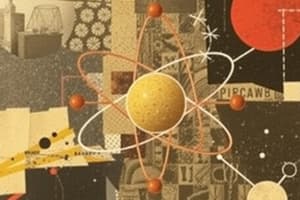Podcast
Questions and Answers
What characterizes an ion of an element?
What characterizes an ion of an element?
- It has a different number of neutrons than protons.
- It is always positively charged.
- It has a different number of electrons than protons. (correct)
- It forms only during nuclear reactions.
Which type of radiation is least penetrating?
Which type of radiation is least penetrating?
- Neutron radiation
- Gamma radiation
- Alpha radiation (correct)
- Beta radiation
Which of the following is a significant risk associated with gamma radiation?
Which of the following is a significant risk associated with gamma radiation?
- It only poses an external hazard.
- It can cause immediate radiation sickness. (correct)
- It is harmless to DNA.
- It can be easily blocked by aluminum.
What is the principle behind nuclear fission?
What is the principle behind nuclear fission?
Which statement accurately describes the challenges of nuclear power generation?
Which statement accurately describes the challenges of nuclear power generation?
Who is notably recognized for creating the periodic table?
Who is notably recognized for creating the periodic table?
In a nuclear fusion reaction, what primarily happens?
In a nuclear fusion reaction, what primarily happens?
Which materials are required for effective shielding against gamma radiation?
Which materials are required for effective shielding against gamma radiation?
What is the effect of DNA damage caused by radiation?
What is the effect of DNA damage caused by radiation?
What are the characteristics of alpha radiation?
What are the characteristics of alpha radiation?
Flashcards are hidden until you start studying
Study Notes
Isotopes
- Isotopes are atoms of the same element that have the same number of protons but a different number of neutrons.
Ions
- An ion is an atom or molecule with a net electrical charge.
- Ions are formed when an atom gains or loses electrons.
- For example, lithium (Li) has a +1 charge (Li+) because it wants to give up one electron.
- Fluorine (F) has a -1 charge (F-) because it wants to gain one electron.
Radiation
- There are three main types of radiation: alpha, beta, and gamma.
- Alpha radiation is composed of helium nuclei.
- Alpha radiation has low penetration power and can be stopped by paper or skin.
- Alpha radiation is dangerous if inhaled, ingested, or enters the body.
- Beta radiation is composed of high-speed electrons or positrons.
- Beta radiation has higher penetration power than alpha radiation and can be stopped by aluminum or plastic.
- Beta radiation is an external hazard and is more harmful than alpha radiation.
- Gamma radiation is high-frequency electromagnetic radiation with very high penetration power.
- Gamma radiation requires dense materials like lead for shielding.
- Gamma radiation causes deep tissue and organ damage, including DNA damage, leading to cancer or radiation sickness.
DNA Damage and Cellular Damage
- Radiation can damage DNA, leading to cancer or cell death.
- High doses of radiation can cause acute radiation syndrome.
Benefits and Disadvantages of Nuclear Power Generation
Benefits
- High energy output
- Low greenhouse gas emissions
- Reliable source of electricity
Disadvantages
- Potential for accidents, such as Chernobyl or Fukushima
- Challenges in disposing of long-lived radioactive waste
- High initial construction and decommissioning costs
Nuclear Reactions Overview
Nuclear Reactors
- Nuclear reactors use nuclear fission to generate energy.
- Nuclear fission is the process of splitting a heavy atomic nucleus into smaller nuclei by bombarding it with neutrons.
- This process releases energy and more neutrons, creating a chain reaction.
Atomic Bombs
- Atomic bombs use uncontrolled nuclear fission or fusion to create an explosion.
- Fission bombs use a rapid, uncontrolled chain reaction of nuclear fission.
- Fusion bombs (hydrogen bombs) fuse hydrogen isotopes under high pressure and temperature, releasing immense energy.
Pioneers in Periodic Table and Radiation Study
- Dmitri Mendeleev created the periodic table.
- Henri Becquerel discovered radioactivity.
- Ernest Rutherford investigated and identified the structure of the atom and the nature of radioactive decay.
Nuclear Fusion
- Nuclear fusion occurs when two small atomic nuclei collide and combine to form a larger nucleus, releasing energy.
- For example, hydrogen atoms fuse together to form helium in the reactions of stars and hydrogen bombs.
Nuclear Fission
- Nuclear fission occurs when a neutron collides with a larger atom, causing it to split into two smaller atoms, releasing energy.
Studying That Suits You
Use AI to generate personalized quizzes and flashcards to suit your learning preferences.




